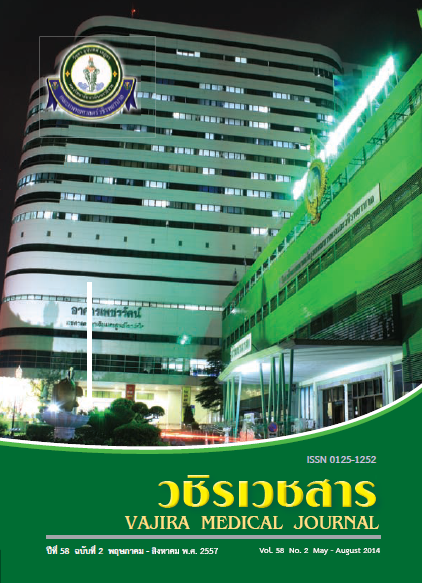A Retrospective Study of Prevalence and Metastatic Patterns of Female Breast Cancer Among Immunopathological Subtypes According to St. Gallen 2011 International Expert Consensus in Faculty of Medicine Vajira Hospital
Main Article Content
Abstract
Objective: Breast cancer is one of the world-wide most prevalent cancers in female. Even though recent breakthroughs of breast cancer management leads to decrease in mortality, some patients still suffer from recurrence and metastatic diseases. Like other solid malignancies, metastatic breast cancer is rarely curable. 2011 St. Gallen Internal Expert Consensus initiated the paradigm of stratification of breast cancer patients into intrinsic subtypes in order to predict outcomes and determine proper managements. This study is to verify how useful this stratification is in terms of prognosis.
Methods: We conducted a retrospective descriptive study by collecting data of breast cancer patients treated in Vajira hospital from January 1, 2006 to December 31, 2011 from electronic and manual medical records. There were 171 patients eligible for the study. Baseline characteristics included age, stage at diagnosis, histopathology, tumor size, lymphovascular invasion, history of neoadjuvant chemotherapy, and type of surgery were retrieved and analyzed. Association between intrinsic subtypes and sites of metastases were assessed using univariate and logistic regression analysis. The difference in disease-free survival between intrinsic subtypes was determined using Kaplan-Meier survival analysis and log-rank test.
Results: Among 171 female breast cancer patients eligible for the study, 17 were stage 1 (10.1%), 61 were stage 2 (35.6%), 65 were stage 3 (38%), and 26 were stage 4 (15.3%). No specific baseline characteristic was associated with more prevalence in any particular subtypes. Luminal A subtype was associated with lower tendency to metastasize to visceral and non-visceral organs. Luminal B subtype was associated with statistically significantly more non-visceral organ metastases (OR=2.691; p=0.028). HER2 enriched subtype was associated with statistically significantly more visceral organ metastases (OR=3.771; p=0.015). Since this study had a rather short period of follow-up time (median follow-up time of 75 months), it could not elicit any differences in either disease-free survival or overall survival, although HER2 enriched subtype tended to recurrent more rapidly than other subtypes.
Conclusion: Stratification of female breast cancer into intrinsic subtypes using only IHC methods and Ki-67 according to St. Gallen 2011 International Expert Consensus can predict the metastatic pattern. Luminal A subtype tends to recur least likely. Luminal B subtype tends to metastasize to non-visceral organs more frequently than other subtypes. HER2 enriched subtype tends to metastasize to visceral organs most frequently. This paradigm of disease stratification is practical for using in clinical practice.


